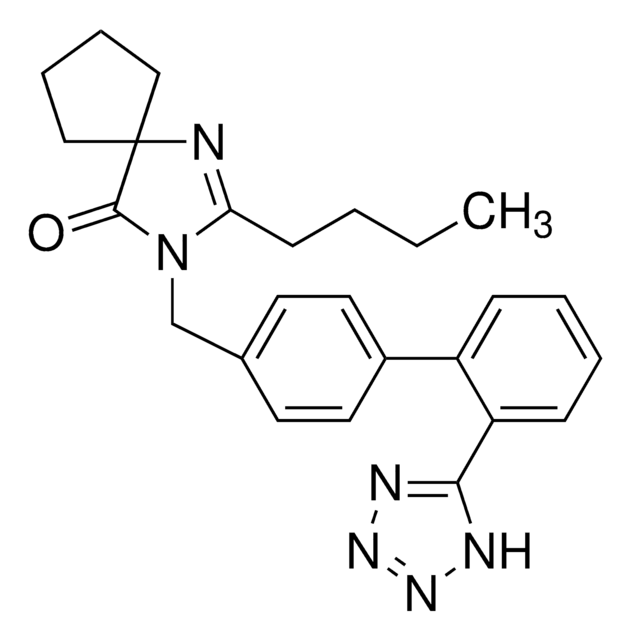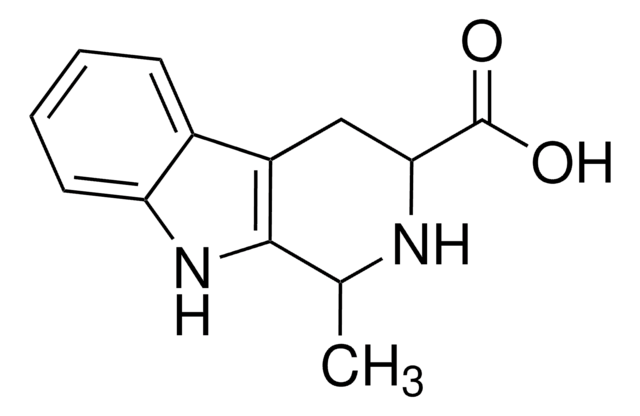SML2786
WRG-28
≥98% (HPLC)
Synonym(s):
DDR2 inhibitor WRG-28, N-Ethyl-4-[[(3-oxo-3H-phenoxazin-7-yl)oxy]methyl]-benzenesulfonamide
Sign Into View Organizational & Contract Pricing
All Photos(1)
About This Item
Empirical Formula (Hill Notation):
C21H18N2O5S
CAS Number:
Molecular Weight:
410.44
MDL number:
UNSPSC Code:
12352200
NACRES:
NA.77
Recommended Products
Quality Level
Assay
≥98% (HPLC)
form
powder
color
white to very dark orange
solubility
DMSO: 2 mg/mL, clear
storage temp.
2-8°C
Biochem/physiol Actions
WRG-28 is a potent, selective and extracellularly acting allosteric inhibitor of discoidin domain receptor 2 (DDR2) that potently inhibits invasion and migration in mice model of breast cancer. WRG-28 inhibits metastatic breast tumor cell colonization in the lungs.
Storage Class Code
11 - Combustible Solids
WGK
WGK 3
Flash Point(F)
Not applicable
Flash Point(C)
Not applicable
Certificates of Analysis (COA)
Search for Certificates of Analysis (COA) by entering the products Lot/Batch Number. Lot and Batch Numbers can be found on a product’s label following the words ‘Lot’ or ‘Batch’.
Already Own This Product?
Find documentation for the products that you have recently purchased in the Document Library.
Saumya S Gurbani et al.
Tomography (Ann Arbor, Mich.), 5(1), 53-60 (2019-03-12)
Histone deacetylases regulate a wide variety of cellular functions and have been implicated in redifferentiation of various tumors. Histone deacetylase inhibitors (HDACi) are potential pharmacologic agents to improve outcomes for patients with gliomas. We assessed the therapeutic efficacy of belinostat
Pengwei Lu et al.
Artificial cells, nanomedicine, and biotechnology, 47(1), 3955-3960 (2019-10-02)
Belinostat is a histone deacetylase inhibitor drug capable of regulating cell growth in diverse cancers. Nonetheless, little information clarified the role of Belinostat in breast cancer. Hence, the functions of Belinostat in breast cancer cells survival was disclosed in this
Li Ren Kong et al.
Nature communications, 11(1), 2086-2086 (2020-05-01)
Gain of function (GOF) DNA binding domain (DBD) mutations of TP53 upregulate chromatin regulatory genes that promote genome-wide histone methylation and acetylation. Here, we therapeutically exploit the oncogenic GOF mechanisms of p53 codon 158 (Arg158) mutation, a DBD mutant found
Wen Chiy Liew et al.
The Journal of allergy and clinical immunology, 146(3), 606-620 (2020-02-24)
Atopic dermatitis (AD) is a common chronic inflammatory skin disease. Skin barrier defects contribute to disease initiation and development; however, underlying mechanisms remain elusive. To understand the underlying cause of barrier defect, we investigated aberrant expression of specific microRNAs (miRNAs)
Our team of scientists has experience in all areas of research including Life Science, Material Science, Chemical Synthesis, Chromatography, Analytical and many others.
Contact Technical Service






![trans-4-[4-(Dimethylamino)styryl]-1-methylpyridinium iodide Dye content 98 %](/deepweb/assets/sigmaaldrich/product/structures/416/722/5d59b6c3-5f2d-4396-a721-5cb82ba7038c/640/5d59b6c3-5f2d-4396-a721-5cb82ba7038c.png)